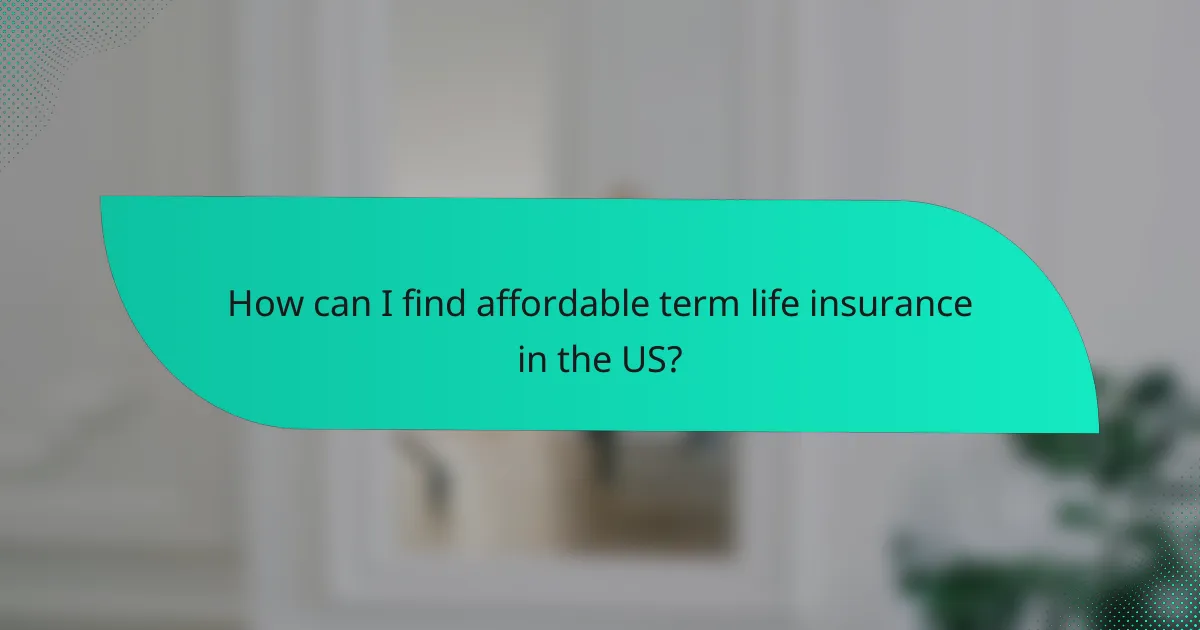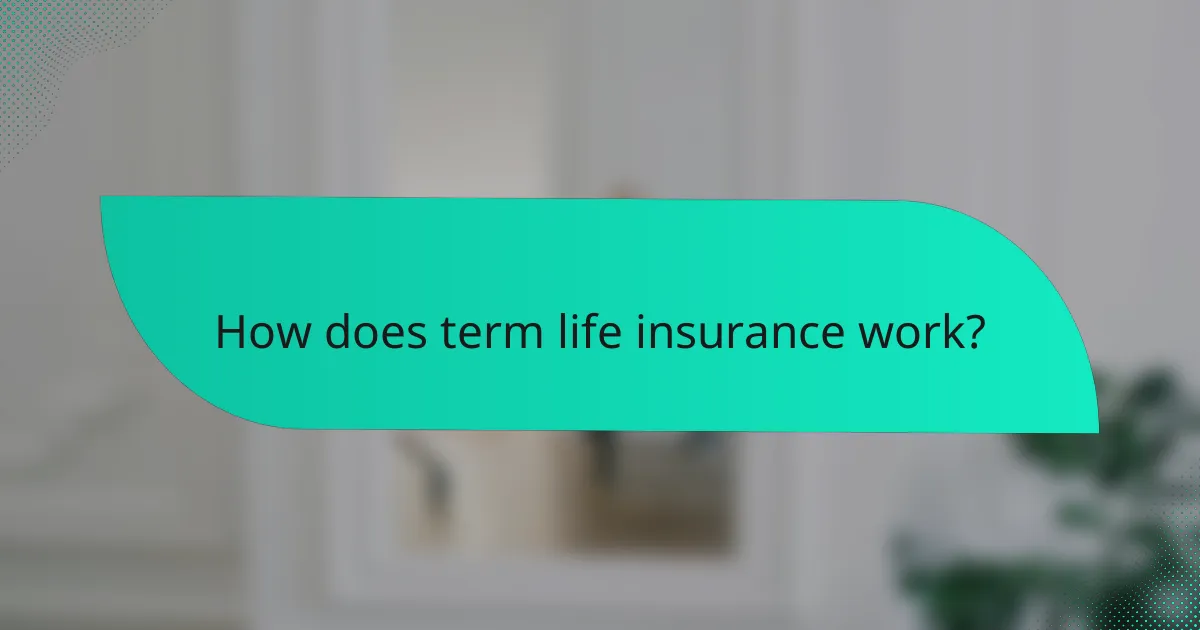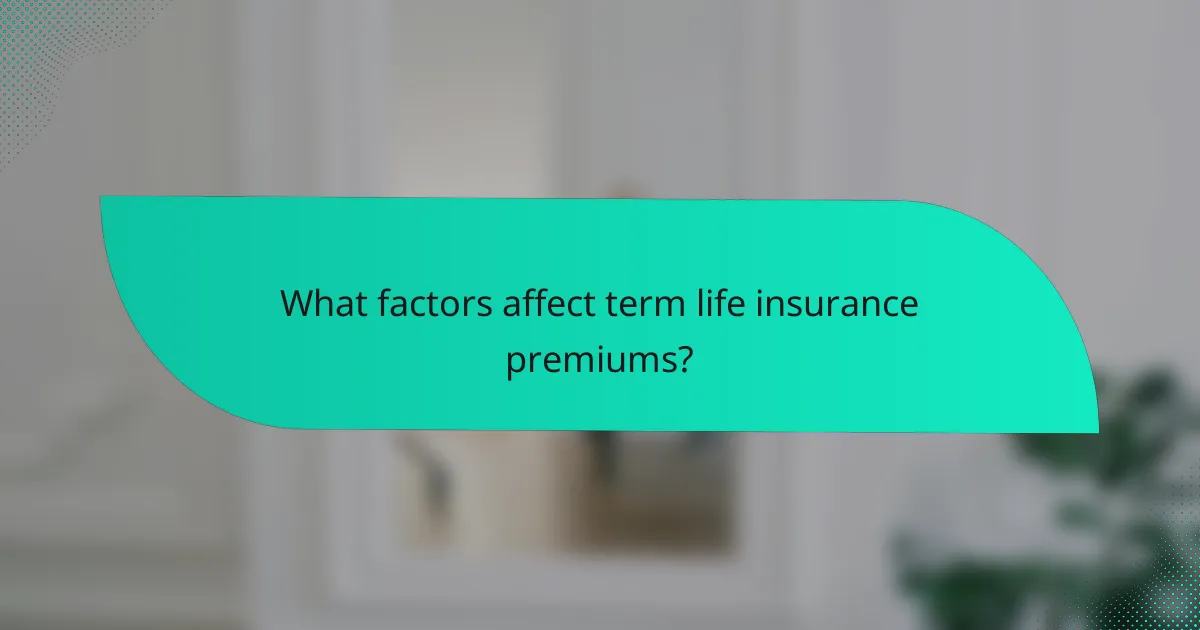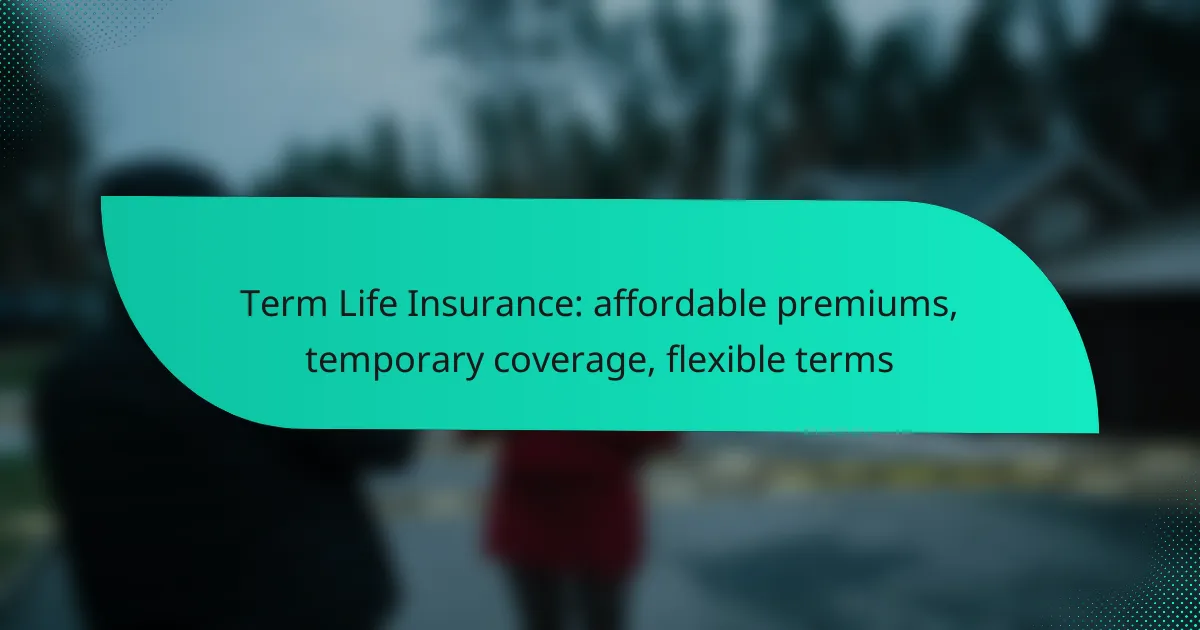Term life insurance is an excellent option for those seeking affordable premiums and temporary coverage tailored to their needs. With flexible terms typically ranging from 10 to 30 years, this type of policy provides financial protection for a specific period, ensuring peace of mind for individuals and families. By comparing quotes from various providers, you can find a plan that fits your budget and coverage requirements.

How can I find affordable term life insurance in the US?
To find affordable term life insurance in the US, compare quotes from multiple providers and consider factors like your age, health, and coverage needs. Many insurers offer online tools to help you estimate premiums based on these variables.
Comparison of top providers
When comparing top term life insurance providers, look for companies with strong financial ratings and positive customer reviews. Major players like State Farm, Prudential, and AIG typically offer competitive rates and various policy options.
Utilize online comparison tools to view quotes side by side. This can help you identify the best coverage for your budget and needs, ensuring you don’t overlook important features like conversion options or riders.
Discount options for healthy individuals
Healthy individuals often qualify for lower premiums due to their reduced risk profile. Many insurers provide discounts for non-smokers, those who maintain a healthy weight, or individuals with no chronic health issues.
Additionally, some companies offer wellness programs that can further reduce costs. Engaging in regular health check-ups and maintaining a healthy lifestyle can lead to significant savings on your term life insurance premiums.
State-specific premium variations
Term life insurance premiums can vary significantly by state due to factors like local regulations, cost of living, and demographic health trends. For instance, residents in states with higher healthcare costs may face higher premiums.
It’s essential to research state-specific factors that could impact your rates. Consulting with a local insurance agent can provide insights into the best options available in your area, ensuring you get the most affordable coverage possible.

What are the benefits of term life insurance?
Term life insurance offers several advantages, including affordable premiums, temporary coverage, and flexible terms. This type of policy is designed to provide financial protection for a specific period, making it a practical choice for many individuals and families.
Lower premiums compared to whole life
One of the most significant benefits of term life insurance is its lower premiums compared to whole life insurance. Since term policies do not build cash value and are only in effect for a limited time, they typically cost less, making them accessible for those on a budget.
For example, a healthy 30-year-old might pay around $20 to $30 per month for a 20-year term policy with a coverage amount of $500,000. In contrast, a whole life policy could cost several times that amount for the same coverage.
Flexibility in coverage duration
Term life insurance provides flexibility in choosing the duration of coverage, which can range from one year to 30 years or more. This allows policyholders to align their insurance needs with life events, such as raising children or paying off a mortgage.
For instance, if you only need coverage while your children are dependents, a 20-year term might be ideal. Once the term ends, you can reassess your needs and decide whether to renew, convert to a permanent policy, or let it expire.
Simple application process
The application process for term life insurance is generally straightforward and can often be completed online. Many insurers offer instant quotes and quick approvals, making it easier for individuals to secure coverage without extensive paperwork.
Typically, applicants will need to provide basic information about their health and lifestyle, and some may undergo a medical exam. This simplicity allows for faster access to life insurance, which can be crucial during significant life changes.

How does term life insurance work?
Term life insurance provides temporary coverage for a specified period, typically ranging from 10 to 30 years. It pays a death benefit to beneficiaries if the insured passes away during the term, making it an affordable option for those seeking financial protection for a limited time.
Coverage period explanation
The coverage period of term life insurance is predetermined and can vary widely. Common terms include 10, 15, 20, or 30 years, allowing policyholders to choose a duration that aligns with their financial responsibilities, such as raising children or paying off a mortgage.
At the end of the term, the coverage expires, and there is no payout unless the policy is renewed or converted to a permanent policy. Some policies offer a guaranteed renewal option, but premiums may increase significantly upon renewal.
Premium payment structure
Premiums for term life insurance are generally lower than those for permanent life insurance, making it an attractive choice for budget-conscious individuals. Payments can be made monthly, quarterly, or annually, depending on the policy terms.
Premiums are typically fixed for the duration of the term, providing predictability in budgeting. However, factors such as age, health status, and lifestyle choices can influence the cost, so it’s essential to compare quotes from different insurers.
Claim process overview
To initiate a claim on a term life insurance policy, beneficiaries must provide a death certificate and complete a claim form. The insurer will review the claim to ensure the policy was active at the time of death and that all terms were met.
Once approved, the insurer typically disburses the death benefit within a few weeks. It’s advisable for policyholders to inform their beneficiaries about the policy details and the necessary steps to take in the event of a claim, ensuring a smoother process during a difficult time.

What factors affect term life insurance premiums?
Term life insurance premiums are influenced by several key factors, including the insured’s age, health status, occupation, lifestyle choices, and the coverage amount selected. Understanding these elements can help you estimate costs and make informed decisions about your policy.
Age and health status
Your age and overall health are primary determinants of term life insurance premiums. Generally, younger individuals with fewer health issues will pay lower premiums compared to older applicants or those with pre-existing conditions. Insurers often require medical exams or health questionnaires to assess risk.
For instance, a healthy 30-year-old may pay significantly less than a 50-year-old with health concerns. It’s essential to compare quotes from different insurers, as some may offer better rates based on your specific health profile.
Occupation and lifestyle choices
Your occupation and lifestyle choices can also impact your term life insurance premiums. High-risk jobs, such as those in construction or aviation, may lead to higher rates due to the increased likelihood of accidents. Similarly, lifestyle choices like smoking or excessive drinking can elevate premiums.
To potentially lower your costs, consider engaging in healthier habits or seeking employment in lower-risk fields. Some insurers offer discounts for policyholders who demonstrate improved health or engage in wellness programs.
Coverage amount selected
The amount of coverage you choose directly affects your term life insurance premiums. Higher coverage amounts will result in higher premiums, as insurers are taking on more risk. It’s crucial to assess your financial obligations and family needs when determining the right coverage level.
A common guideline is to select a coverage amount that is 10 to 15 times your annual income. This can provide a safety net for your beneficiaries, ensuring they are financially secure in your absence. Always compare different coverage options to find a balance between adequate protection and affordability.

How do I choose the right term length?
Choosing the right term length for your life insurance policy depends on your financial goals and family needs. Typically, term lengths range from 10 to 30 years, allowing you to align coverage with significant life events or obligations.
Common term lengths available
Term life insurance policies generally offer several common lengths, including 10, 15, 20, and 30 years. A 10-year term may be suitable for short-term financial responsibilities, while a 30-year term is often chosen for long-term commitments, such as raising children or paying off a mortgage. Selecting a term that matches your life stage can help ensure adequate coverage during critical periods.
Considerations for family needs
When determining the appropriate term length, consider your family’s future financial needs. If you have young children, a longer term may provide peace of mind, ensuring they are supported until they become financially independent. Conversely, if your children are nearing adulthood, a shorter term might suffice, as your financial responsibilities may decrease over time.
Impact of financial obligations
Your financial obligations play a crucial role in selecting a term length. Assess your current debts, such as mortgages, student loans, and other liabilities, to determine how long you need coverage. For instance, if you have a 20-year mortgage, a 20-year term policy may be ideal to cover that obligation until it is paid off. Regularly reviewing your financial situation can help you adjust your term length as needed.

What are the limitations of term life insurance?
Term life insurance has several limitations that potential policyholders should consider. Primarily, it provides coverage for a specific period and lacks certain benefits found in permanent life insurance policies.
No cash value accumulation
One significant limitation of term life insurance is that it does not build cash value over time. Unlike whole or universal life insurance, which allows policyholders to accumulate savings within the policy, term life insurance strictly offers a death benefit if the insured passes away during the term.
This means that once the policy expires, there is no financial return or payout for the premiums paid. For individuals seeking an investment component alongside life coverage, term life may not meet their needs.
When considering term life insurance, it’s essential to weigh the lack of cash value against the lower premiums. If you are looking for affordable coverage without the investment aspect, term life can be a suitable option, but be aware that you won’t receive any funds back if you outlive the policy term.
